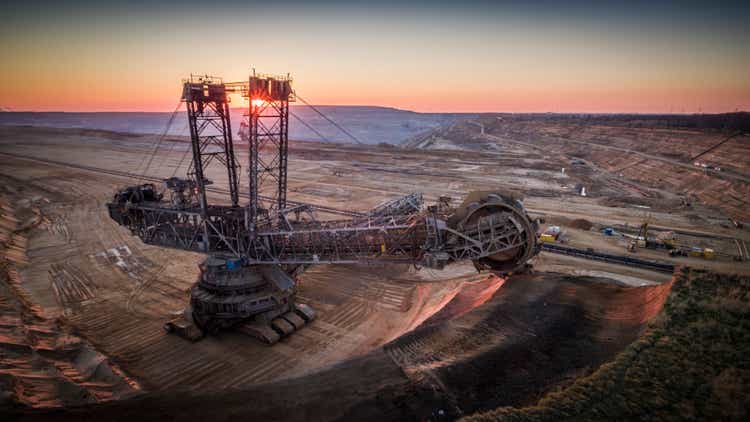[ad_1]
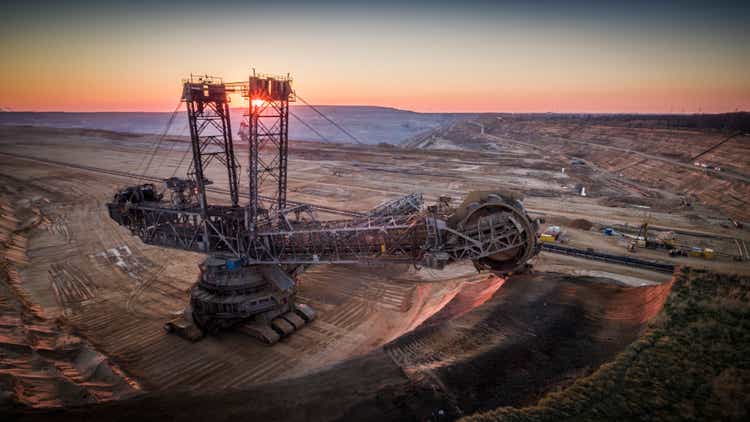
Schroptschop/E+ via Getty Images
iShares MSCI Global Metals & Mining Producers ETF (BATS:BATS:PICK) is an exchange-traded fund that provides investors with exposure to companies involved in the extraction and production of diversified metals, aluminum, steel, precious metals and minerals. The expense ratio of the fund is 0.39%. Assets under management were $1.654 billion as of May 27, 2022.
I last covered PICK in late 2021, and believed that it was a “strong buy” as I thought it was undervalued on the basis of its fundamental valuation. Since then, PICK is up almost 18% on a total return basis, while the S&P 500 index is about 8.6% lower.
Given the commodity complex is typically volatile and unpredictable, PICK seems to carry a fairly high implied equity risk premium, but this can be to your benefit if your investment is reasonably well-timed. You have to be prepared to stomach high downside volatility, but your overall long-term return can be strong if you hold through storms.
Net fund flows over the past year, into PICK, have been positive, mostly back-loaded (into the first quarter of 2022).
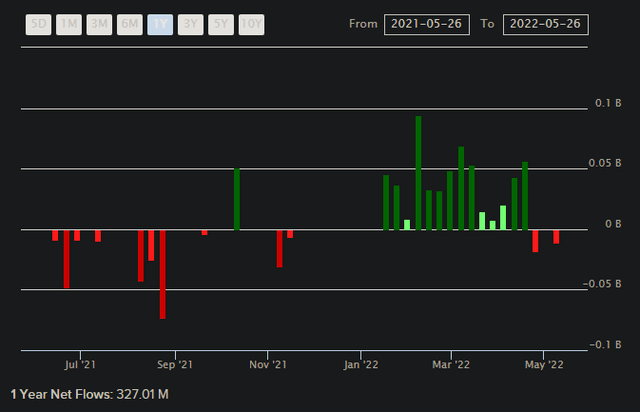
ETFDB.com
Sentiment has improved as inflation expectations initially rose (whose upward trajectory bond yields also naturally followed). Companies that extract, produce and sell commodities are technically “short commodities”, although rising prices tend to help support margins, especially when rising prices are accompanied by increased trading volumes. Companies with less aggressive hedging strategies can also gain from rising prices. Risk premiums embedded in the valuations of commodities producers tends to contract too. So, cash flows improve and multiples improve. PICK has also been buoyed by net inflows (improving risk sentiment, helping to underpin those better valuations). Still, PICK is not above its all-time highs.
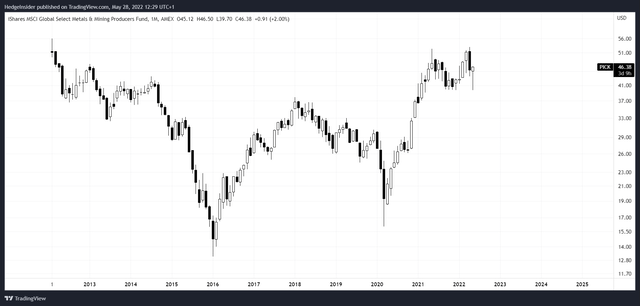
TradingView.com
Yet past price is irrelevant to current value, although admittedly past prices can help you guess at forward multiples. The fund’s benchmark index is MSCI ACWI Select Metals & Mining Producers Ex Gold & Silver Investable Market Index; quite a mouthful. Here is a link to the most recent fact sheet. We can use the fact sheet, as of April 29, 2022, to guide our valuation. The forward price/earnings multiple was just 7.30x, with a trailing price/earnings ratio of 6.77x. (We will revisit this shortly, but note here that this implies a fall in projected nominal earnings.) The price/book ratio (again, relying on the fund’s benchmark index, which it seeks to replicate) was 1.85x. The dividend yield was 6.21%. That implies a distribution rate on earnings of about 42%, excluding buybacks.
The fund is exposed to various countries, although as I have noted before when discussing commodity-related funds, the country exposures listed in these funds’ fact sheets tend not to best reflect their economic exposures. For example, if a large metals company is listed on the London Stock Exchange, it might be classed as a U.K. company even if most of its economic activities sit outside the U.K. (this explains Anglo American plc (OTCQX:AAUKF), by the way; the stock represented over 5% of the PICK portfolio as of May 26, 2022). Nevertheless, the fund’s country exposures are pictured below.
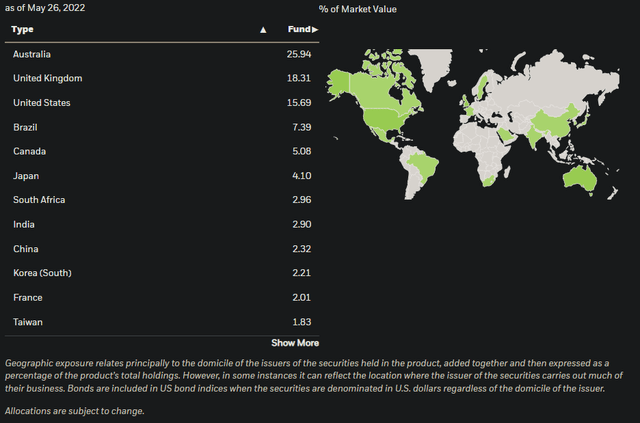
iShares.com
Ordinarily, when valuing a fund like PICK, I would look to a weighted risk-free rate. However, you have to take a global approach here really, due to the scattered nature of this industry’s operations. It is difficult to value portfolios like PICK’s, inherently, which probably explains elevated equity risk premiums embedded in the valuations of the fund’s holdings (in aggregate, at least). But again, this presents opportunity.
Still, these sorts of companies do go through cycles. Morningstar project three- to five-year earnings growth of 15.45% on average, at present. Given that MSCI’s fact sheet for PICK’s underlying index forecasts a drop over the next year, probably following a general normalization in the commodities space after a buoyant past twelve months, we should probably still err on the side of conservativeness. I am going to assume a general drop in the forward rate of return on equity, from over 25% based on MSCI data (implied by the forward price/earnings and price/book ratios) down to about 16% in my terminal year six, which is based on a gradually falling ROE until earnings growth hits 2%.
For now, I will also just assume that the dividend distribution rate is about 42% and not include the effect of any share buybacks. As shown below, this results in a three- to five-year earnings growth rate well under consensus, of really only up to 1.00% per year (after accounting for a drop in year one). The two-to-five-year earnings growth rate is still only about 2.5% per annum.

Author’s Calculations
If we hold the forward price/earnings ratio constant to arrive at a terminal value in year five, based on our projected earnings in year 6 (the terminal year), we get an implied IRR of over 16%.

Author’s Calculations
If we put a nominal and somewhat arbitrary risk-free rate of 3.00% in there for the moment, the implied equity risk premium is over 13%, all in. That is, independent of the fair cost of equity, the estimated return for investing in the PICK portfolio on a total return basis.
Equity risk premiums fluctuate through different regimes based on general investor risk sentiment and/or risk aversion. The table below divides the embedded risk premium of PICK into several example ERPs, including an elevated 5.5%. ‘RR’ is the product, i.e., relative risk. It seems as though the implied share price change should be circa 100% (or more), i.e., there is potentially still plenty of upside in investing in PICK.

Author’s Calculations
However, I don’t imagine PICK will revise upward in such an aggressive fashion, as the fund is more volatile and unpredictable than more popular and diversified equity index funds. Still, I think it is still likely appealing to be holding PICK, as it could enable you to passively harvest that elevated risk premium over time if you hold through the volatility.
If I increase our risk-free rate to 5% (safely above the current U.S. 10-year of less than 3% at present), the relative risk on an ERP of 5.5% would still be over 2x, with 60% implied upside on the valuation. Then again, if we just keep the forward price/earnings ratio constant and collect on the company’s earnings power over the next few years, your implied IRR is still going strong. We can basically hold the high embedded risk premium constant and still do well holding commodities producers, provided there is no outright calamity over the next few years.
It is possible that, with falling inflation expectations, you might see weaker risk sentiment among commodities producers. But I think valuations are already low enough to probably still justify holding. Stronger risk sentiment across the board will probably lift all boats, including ETFs like PICK. This might be especially so if the U.S. avoids a recession in the near term; and based on Fidelity estimates, the U.S. hasn’t even entered ‘late-stage’ yet in its current business cycle.
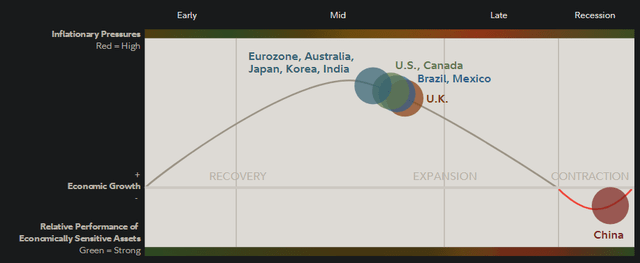
Fidelity.com
While we might see slowing growth and weaker inflation expectations, which are not ordinarily constructive for commodities stocks, PICK’s implied return is likely high (even higher than my estimate, given my more conservative approach), and if a near-term recession does not come to pass, it is possible that these funds (and equities in general) will do very well.
[ad_2]
Source links Google News

